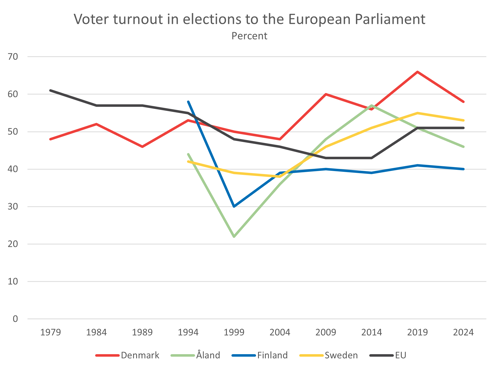Election to the European Parliament 2024 - Voter Turnout
Over 50 percent of the eligible citizens in the 27 countries of the EU voted in the European parliamentary elections in 2024, the highest voter turnout since 1994. In the four Nordic member states and regions, voter turnout was between 40 and 58 percent, and in all four the turnout was lower than in the previous election.
The 2024 European Parliament election was held in the European Union (EU) between June 6th and June 9th 2024. It was the tenth parliamentary election since the first direct elections in 1979, and the first European Parliament election after Brexit. A total of 720 Members of the European Parliament (MEPs) were elected to represent more than 450 million people from 27 member states.[1]
Of the eight Nordic countries and self-governing regions, four are members of the European Union. Denmark has been a member of the EU since its formation in 1993 and was a member of the European Community (EC) before that, meaning that Danish eligible citizens have been able to vote since the first election in 1979. Finland, Åland and Sweden joined in 1995. An ordinary election had just been held, in 1994, so an extraordinary EU election was held in Sweden in 1995 and in Finland and Åland in 1996.
Voter turnout over time
51 percent of the eligible citizens in the 27 countries of the EU voted in the European parliamentary elections in 2024.The highest turnout occurred in the first set of European parliamentary elections, held in 1979, in which 61 percent of eligible Europeans voted. Voter turnout then declined in every election, reaching a low of 43 percent in 2009/2014. In 2019, it increased to 51 percent, the same level as in the 2024 election.

Source: Nordic Statistics Database, EUPD01
Of the four Nordic countries, two had a higher voter turnout than the EU, while two had a lower turnout.
Denmark had the highest turnout of the four countries, with 58 percent. This still meant a decrease compared to 2019, when participation was a record high 66 percent. The lowest turnout was in 1989, when 46 percent of eligible citizens voted.
Sweden had the second highest turnout at 53 percent, also a decrease compared to 2019 when the turnout was the highest ever in Sweden, 55 percent. The lowest turnout was in 2004, when 38 percent of eligible citizens voted. [2]
Finland has had a steady, relatively low participation since 2004 of around 40 percent, which also was the outcome in 2024. Their all-time high was in 1996, the first year Finnish citizens could vote in the EU elections, when voter turnout was 58 percent. [2]
Voter turnout on Åland has developed differently than in Finland overall. The highest, 57 percent, was noted in the 2014 election, after an increase in turnout for three consecutive elections. Since then, it has fallen and in 2024 it was 46 percent. This is, however, still six percentage points higher than the voter turnout in Finland in the same election. The lowest turnout was in 1999, when 22 percent of eligible citizens voted. [2]
_______________________________________________________________________
[1] https://en.wikipedia.org/wiki/2024_European_Parliament_election
[2] Please note that Åland is included in the value for Finland.
[3] Sweden, Finland and Åland became members of the European Union in 1995. 1994 here refers to the extraordinary elections to the European Parliament held in 1995 and 1996, respectively.
_______________________________________________________________________